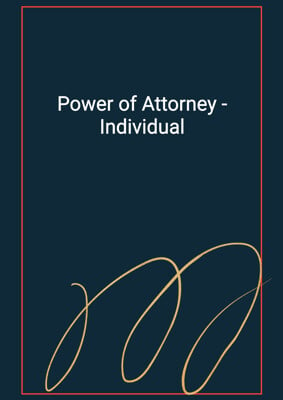
Security Trust Agreement
Trust Receipt
A Trust Receipt is a document to give physical possession of the goods or an asset to a borrower with the bank retaining the ownership of the asset or goods. It is used when a buyer has a loan or any other arrangement from a bank to buy an asset or goods and serves as a promissory note to the bank that the loan amount will be repaid.
How to Tailor the Document for Your Need?
01
Create Document
Fill in the details of the parties. You can click the "Fill with Member’s Information" button to complete it with information saved to your account.
02
Fill Information
Please fill in any additional information by following the step-by-step guide on the left hand side of the preview document and click the "Next" button.
03
Get Document
When you are done, click the "Get Document" button and you can download the document in Word or PDF format.
04
Review Document
The document should be signed by the authorised signatory (or directors of a company) and witnessed to complete the formality.
Document Preview
Document Description
The Security Trust Agreement is a legal document that establishes a trust relationship between the borrower and the guaranteeing bank. The document begins with a brief introduction, stating that it is made between the borrower and the bank. It highlights the importance of the document, which is to secure the bank's interest in the merchandise or documents of title that the borrower will receive from the bank.
The document consists of several sections, each serving a specific purpose. The first section, numbered as section 1, outlines the agreement between the borrower and the bank. It states that the borrower agrees to hold the merchandise or documents of title as a trustee for the bank and to deal with them only as specified in the agreement.
Section 2 defines the term 'documents of title' and clarifies that it includes any documents related to the merchandise, whether delivered to the bank or not. This section ensures that both parties have a clear understanding of the scope of the agreement.
Section 3 requires the borrower to submit or deliver a schedule of the merchandise or documents of title to the bank each time they are released. However, it states that the failure to do so will not affect the validity of the trust. This section aims to keep the bank informed about the whereabouts of the merchandise.
Section 4 emphasizes that the merchandise and documents of title are held at the borrower's risk and expense, but they remain vested in the bank. This section clarifies that the borrower does not become the lawful holder of the merchandise for the purposes of certain legislations.
Section 5 states that the borrower will warehouse the merchandise solely for the purpose of selling it on behalf of the bank. This section ensures that the merchandise is stored appropriately and ready for sale.
Section 6 requires the borrower to warehouse the merchandise in the name of the bank or as directed by the bank. It also grants the bank the right to inspect the merchandise at any time. This section aims to ensure that the bank has control over the merchandise.
Section 7 obligates the borrower to keep the merchandise covered by insurance at all times. It specifies the minimum insurance amount and requires the borrower to provide evidence of insurance to the bank. This section aims to protect the bank's interest in case of any damage or loss to the merchandise.
Section 8 requires the borrower to keep the merchandise separate from other goods or products and to keep all transactions related to the merchandise separate as well. It also grants the bank the authority to receive the proceeds of any sale directly. This section ensures that the bank's interest in the merchandise is protected.
Section 9 prohibits the borrower from selling or disposing of the merchandise without the bank's written consent. It aims to prevent any unauthorized actions that may jeopardize the bank's interest.
Section 10 requires the borrower to forward copies of sales invoices to the bank and remit the proceeds of the sale without any deduction. This section ensures that the bank receives the full amount from the sale of the merchandise.
Section 11 grants the bank the right to demand the return of the merchandise or any part thereof that remains unsold. It also requires the borrower to comply with any instructions given by the bank regarding the merchandise. This section aims to protect the bank's interest in case of non-compliance by the borrower.
Section 12 obligates the borrower to ensure that all rents in respect of any warehouse or premises where the merchandise is held are paid in advance or when due. It also grants the bank the authority to make payments to warehousemen or landlords if necessary. This section aims to prevent any disruptions in the warehousing of the merchandise.
Section 13 requires the borrower to indemnify the bank against any losses, actions, claims, expenses, demands, and liabilities arising from the release of the documents of title or any other actions related to the merchandise. This section aims to protect the bank from any legal or financial consequences.
Section 14 addresses the situation where the borrower becomes a lawful holder of the bill of lading relating to the merchandise. It requires the borrower to take necessary steps to protect the bank's rights against the carrier and hold any recoverable sums on trust for the bank. This section aims to ensure that the bank's rights are preserved in case of any claims against the carrier.
Section 15 confirms that the covenants, obligations, provisions, and powers given or acknowledged in a previous memorandum shall continue to be enforceable in favor of the bank. This section ensures that the bank's rights under the previous agreement are not affected by the execution of this deed.
Section 16 states the jurisdiction clause, specifying the jurisdiction in which any disputes arising from the agreement will be resolved.
Section 17 clarifies that if any provision of the deed is held to be void or unenforceable, the other provisions will remain valid.
Section 18 states that a person who is not a party to the deed has no right to enforce its terms.
The document concludes with the signatures of the borrower and the bank, along with the signatures of witnesses or witnessing solicitors.
In summary, the Security Trust Agreement is a comprehensive legal document that establishes a trust relationship between the borrower and the bank. It outlines the rights and obligations of both parties regarding the merchandise or documents of title. The agreement covers various aspects, including the storage, insurance, sale, and protection of the merchandise. It aims to protect the bank's interest and ensure compliance with the agreed terms and conditions.
How to use this document?
1. Take note of the importance of the Security Trust Agreement, which is to secure the bank's interest in the merchandise or documents of title.
2. Familiarize yourself with the different sections of the agreement, each serving a specific purpose.
3. Understand that as the borrower, you are agreeing to hold the merchandise or documents of title as a trustee for the bank and deal with them only as specified in the agreement.
4. Ensure that you submit or deliver a schedule of the merchandise or documents of title to the bank each time they are released.
5. Remember that the merchandise and documents of title are held at your risk and expense, but they remain vested in the bank.
6. Warehouse the merchandise solely for the purpose of selling it on behalf of the bank.
7. Warehouse the merchandise in the name of the bank or as directed by the bank.
8. Keep the merchandise duly covered by insurance at all times and provide evidence of insurance to the bank.
9. Keep the merchandise separate from other goods or products and keep all transactions related to the merchandise separate as well.
10. Forward copies of sales invoices to the bank and remit the proceeds of the sale without any deduction.
11. Comply with any instructions given by the bank regarding the merchandise and return any unsold merchandise upon the bank's demand.
12. Ensure that all rents in respect of any warehouse or premises where the merchandise is held are paid in advance or when due.
13. Indemnify the bank against any losses, actions, claims, expenses, demands, and liabilities arising from the release of the documents of title or any other actions related to the merchandise.
14. Take necessary steps to protect the bank's rights if you become a lawful holder of the bill of lading relating to the merchandise.
15. Understand that the covenants, obligations, provisions, and powers given or acknowledged in a previous memorandum continue to be enforceable in favor of the bank.
16. Be aware of the jurisdiction specified in the agreement for resolving any disputes.
17. Remember that if any provision of the agreement is held to be void or unenforceable, the other provisions remain valid.
18. Keep in mind that only the parties to the agreement have the right to enforce its terms.
Not the right document?
Don’t worry, we have thousands of documents for you to choose from:





















